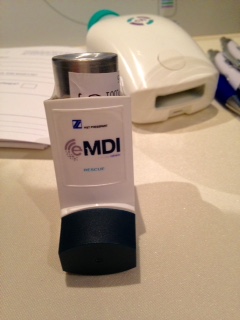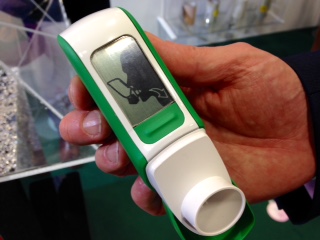
Presspart & Cohero Health’s eMDI

3M’s Intelligent Controller Inhaler
Several connected devices were on display at DDL 27, and Walker also spoke at the launch of Presspart and Cohero Health’s new eMDI on the potential for connected devices to improve adherence and correct technique. In the exhibit hall, 3M DDS displayed its Intelligent Controller Inhaler, which includes a flow governor to ensure proper inhalation technique.
That feature addresses a concern detailed by Henry Chrystyn, Emeritus Professor of Pharmacy at the University of Huddersfield in his talk on “Inhaler device and errors.” Based on soon to be published results of the CRITIKAL inhaler use study, Chrystyn urged the use of inhalers that are more intuitive and with an emitted dose that is less dependent on flow rate.
He particularly emphasized that patients rarely understand the instruction to “inhale slowly” and suggested changing that instruction to “inhale for 5 seconds.” He also stressed that breath hold is important and suggested avoiding giving patients different types of delivery devices since patients using both DPIs and MDIs have been shown to experience a higher rate of exacerbations.
In his talk on “Innovation in Nebulized Delivery,” John Pritchard of Respironics Respiratory Drug Delivery pointed out that nebulizers don’t require coordination and are already e-devices and with the ability to add data collection and training modules. While meetings like DDL and RDD rarely focus on nebulized products, over the past 5 years the use of nebulized drugs has grown twice as fast as inhalers, he noted.
After 60 years, however, the MDI continues as a popular delivery device for inhaled medications, and Tim Noakes and Stuart Corr of Mexichem reassured the audience of the continued availability of HFA 134 and 227 well into the future despite the recent Kigali amendment commitment to a phase down of hydrofluorocarbons. In addition, they described their investigation into the possibility of using HFA 152a as an MDI propellant.
While HFA 152a is slightly flammable, they said, it is less flammable than some currently marketed HFA 134 formulations that include ethanol. For certain actives HFA 152a has such great potential benefits, they said, that if it is approved as a propellant, developers may want to use it in formulations despite the continued availability of medical grade HFAs.


